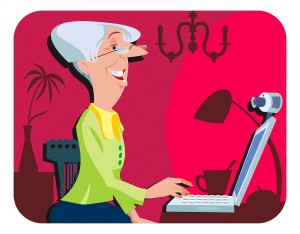 Do we need even one more report on the difficulties that women have staying in the profession? Do we need the ABA to tell us what anyone in the profession with even the teeniest brains knows just by looking around and seeing the attrition of women who boogie out of Biglaw practice? I didn’t think we needed one, but I would be wrong. (Not the first time, and certainly not the last.)
Do we need even one more report on the difficulties that women have staying in the profession? Do we need the ABA to tell us what anyone in the profession with even the teeniest brains knows just by looking around and seeing the attrition of women who boogie out of Biglaw practice? I didn’t think we needed one, but I would be wrong. (Not the first time, and certainly not the last.)
Carolyn Elefant, in a post two years ago, wrote about the ABA Initiative to investigate why mid-career women lawyers are leaving Biglaw.
Here we are, two years later, and guess what? No, don’t guess. I’ll tell you. The ABA report has concluded that “men are from Mars, women are from Venus.” Did we need the ABA to tell us that?

Transform Legal Reasoning Into Business-Ready Results With General AI
Protégé™ General AI is fundamentally changing how legal professionals use AI in their everyday practice.
And if you’re not familiar with the book, “Men Are From Mars, Women Are From Venus,” which was hugely popular in the 1990s (when many of our readers were barely in grammar school), the report nails what the problem is. Indeed, male lawyers are from Mars, and female lawyers are from Venus.
John Gray’s book asserts that men and women have differing ways of communicating (no surprise there), and so they need to understand those different styles. Gray’s book also talks about the different emotional needs that men and women have.
The ABA report, entitled “Walking Out of the Door, The Facts, Figures and Future of Experienced Women Lawyers in Private Practice,” is really nothing new after all the reports we’ve read over the past decade. The report suggests recommendations that “if adopted” (notice the use of “if”) could lead eventually to gender parity in Biglaw. However, I don’t think anyone alive today will still be alive to see that transformation unless the cryogenics business really takes off soon.
The report shows a huge disconnect between how male lawyers view aspects of law firm practice and life differently from their female colleagues. Some of the factors where men and women report differing levels of satisfaction include compensation (and how that compensation is determined), opportunities for advancement, workplace gender diversity, and firm leadership.

How The Law Office Of Stephen L. Thomas Jr. Reclaimed Valuable Hours And Strengthened Client Care With 8am
Founded in 2017, the Baltimore-based Law Office of Stephen L. Thomas Jr. unified case management, communication, and payments with 8am—saving 10–20 hours a week for clients, trials, and growth.
A few of the disparities in what the report terms “everyday building blocks for success”:
How many times has a male lawyer been mistaken for a lower-level employee? According to the survey, never, but 82% (!) of women lawyers said that they have been so mistaken. (And don’t get me started on how women lawyers are expected to plan parties, pick up refreshments, and other housekeeping duties.)
How many men have experienced a lack of access for opportunities for business development? According to the report, a mere 10%, while 67% of the women lawyers haven’t had that access. (Gee, another surprise.)
How about some more? Disparities in how committed women are to their careers, the perception of a hostile work environment, denials in salary increases and/or bonuses, being overlooked for promotion opportunities, lack of sponsors, loss of a desirable assignment. The list goes on.
Men and women have significantly differing views on why women choose to stay or go. Three of the biggest reasons for why women walk out the door: work/life balance (and let’s stipulate that women have just about all of the responsibilities for both children and aging parents), advancement opportunities, and marketing/business origination. There are others, but those three give you a flavor of why women leave.
The report gives an example of a classic Mars v. Venus situation: a large percentage of firm leaders and male partners believe that their firms do a good job to advance experienced women, however, to no woman’s surprise, “experienced women do not share that view.”
Everyone and anyone who has even a smidgen of interest in why experienced women leave should read the report. Men may well be surprised, but women will not.
What should Biglaw firms do differently? I’m not going to provide a list of the report’s suggestions (and I do have a word count limit). You can guess what most, if not all, of them are. The bottom line is pretty simple. “Change the law firm structure and culture so that firms can better address the needs of the many women they recruit and seek to retain.” Well, that’s easy. Not. Setting up policies and procedures is comparatively easy. Implementing them is more difficult. Compliance with them is the hardest part, and who is willing to devote nonbillable hours (at least currently) to be the “enforcer?”
There has to be commitment and not just lip service if this profession is ever going to look like this country. Women make up more than 50 percent of the population, they compose 50 percent of incoming law school classes, and then mid-career, women lawyers turn their backs on Biglaw, saying, in essence, “phooey.” Think about all the training and knowledge that Biglaw has provided only to see experienced women lawyers walking out the door. Not a very good return on the Biglaw firm investment.
 Jill Switzer has been an active member of the State Bar of California for over 40 years. She remembers practicing law in a kinder, gentler time. She’s had a diverse legal career, including stints as a deputy district attorney, a solo practice, and several senior in-house gigs. She now mediates full-time, which gives her the opportunity to see dinosaurs, millennials, and those in-between interact — it’s not always civil. You can reach her by email at [email protected].
Jill Switzer has been an active member of the State Bar of California for over 40 years. She remembers practicing law in a kinder, gentler time. She’s had a diverse legal career, including stints as a deputy district attorney, a solo practice, and several senior in-house gigs. She now mediates full-time, which gives her the opportunity to see dinosaurs, millennials, and those in-between interact — it’s not always civil. You can reach her by email at [email protected].